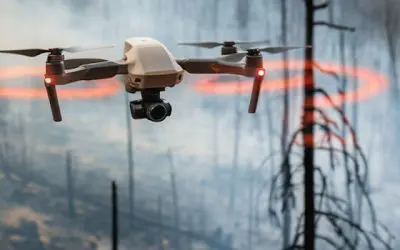As I write this (early September 2024), the Line Fire rages across Southern California, reminding me of the fires that shaped my childhood. Just a few miles from where I grew up, wildfires became a regular part of life. But for me, they were more than just background noise—they became the driving force behind my passion for Forestry and the founding of Talking Tree Ventures.
The flames I witnessed as a child were more than terrifying; they left an indelible mark on my memory and worldview. These formative experiences led me to build a career focused on using technology to optimize Forest Restoration, Forest Economics, and Fire Management. I didn’t just see fires as a natural phenomenon — I saw them as a call to action. And it all started in my backyard.
The Early Days: Fire on the Horizon
My family moved to California when I was seven years old. My father, an Air Force officer, settled us in San Bernardino, where our backyard opened up to the foothills of the San Bernardino mountains. It wasn’t long before I understood that fire was part of life in Southern California. One day, I found myself standing on the playground, watching glowing red embers drift down from above as the wind carried them to us from the nearby fires. The sky was dark, tinged with a strange greenish-brown hue, and everything seemed unreal and urgent.
That night, my dad stayed up on the roof, hosing down the tinder-dry cedar shingles, keeping our house cool while my mom packed the van with five kids and essentials, ready to evacuate. First thing in the morning, however, Dad had to put on his uniform and get to the airbase. Fire or no, my mom was on her own with five young kids, none of us really knowing what was going on. It was the kind of memory that sticks with you—an early realization that while nature’s forces are overwhelming, people can fight back with preparation, resilience, and strategy.
Citrus Avenue was just to the north of our house, and Mom likes to tell how they woke up in the middle of the night to the eerily silent flashing lights from a line of fire trucks, strung along the road like sentinels. Everyone north of that line was being evacuated, and the marshals were thinking about moving the line a little farther south – which would have added us to the evacuation list. Thankfully, the wind shifted and we were able to dodge that bullet.
Fire Management, I would later come to understand, is not just about reacting to fires—it’s about preventing them in the first place. The foundation for Talking Tree Ventures was laid that night as I watched my dad tirelessly work to protect our home.
The Panorama Fire: A Defining Moment
Fast forward to 1980, and I was a high schooler watching a nightmare unfold just a few miles away. The Panorama Fire, driven by fierce Santa Ana winds, tore through Waterman Canyon in November of that year, devouring homes in minutes. The flames didn’t discriminate, swallowing entire neighborhoods in seconds. At the time, it was the fourth-most destructive fire in California history.
That fire wasn’t just another event for me—it was personal. The hills where I had hiked and camped were scorched beyond recognition. Worse, it was set by an arsonist, an unforgivable act in my teenage mind. But the emotional weight of the disaster didn’t end with the fire itself. A few months later, in January, the rains came—and with them, mudslides.
Without vegetation to hold the soil, entire neighborhoods were buried under heavy, thick mud. My high school crew felt we should pitch in and help, so we grabbed our shovels and went to see if we could dig anyone out. The rain and mudslides had stopped, but the houses were covered – literally covered – with heavy brown mud. Everything was starting to dry, and it seemed like the houses had just sunken into the earth. I vividly remember walking up to standing next to one house, where the mud had reached up to the roof. No joke – the roof line was right above my ankles. One low step up and I was on the roof! We went around the corner, climbed down a hill to the driveway and we were able to see the front door. After a busy hour of digging, there was a clear path to get to the front door so the homeowners could venture in to retrieve any remaining valuables.
That day, I learned an important lesson: disasters have knock-on effects. Fires aren’t just a threat when they burn—they continue to wreak havoc long after the flames have been extinguished.
From Fire to ForestTech: Building a Future Through Digital Forestry
The lessons from my youth sunk in crystallized as I’ve grown older. Forest Restoration, Forest Economics, and Fire Management have became more than abstract concepts — they are now central to my career mission. When I founded Talking Tree Ventures, I knew I wanted to address the pressing need for sustainable, technology-driven forestry solutions. The wildfires of my childhood weren’t just tragedies—they were catalysts for innovation.
Today, Talking Tree Ventures is focused on using data and digital tools to help prevent the kind of devastation I saw in California. By leveraging ForestTech, we can monitor fire risks in real-time, develop more efficient forest management plans, and help ecosystems recover after disasters. This isn’t just theory — it’s a mission grounded in my own experience with the destructive power of fire.
The future of fire management and forest restoration lies in the hands of entrepreneurs and investors who understand the value of sustainable solutions. Join our mission at Talking Tree Ventures — subscribe to our mailing list, share your thoughts in the comments, and stay tuned for more insights into how technology and entrepreneurship can save our forests and our planet.






0 Comments